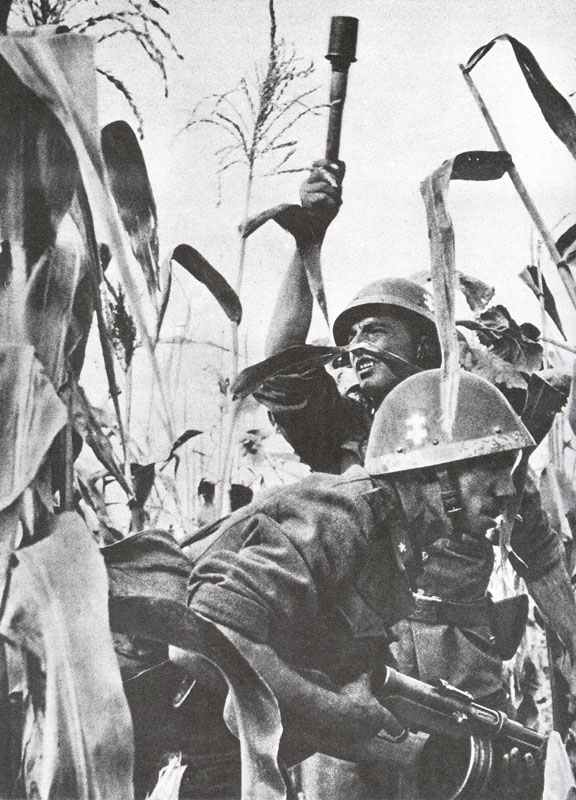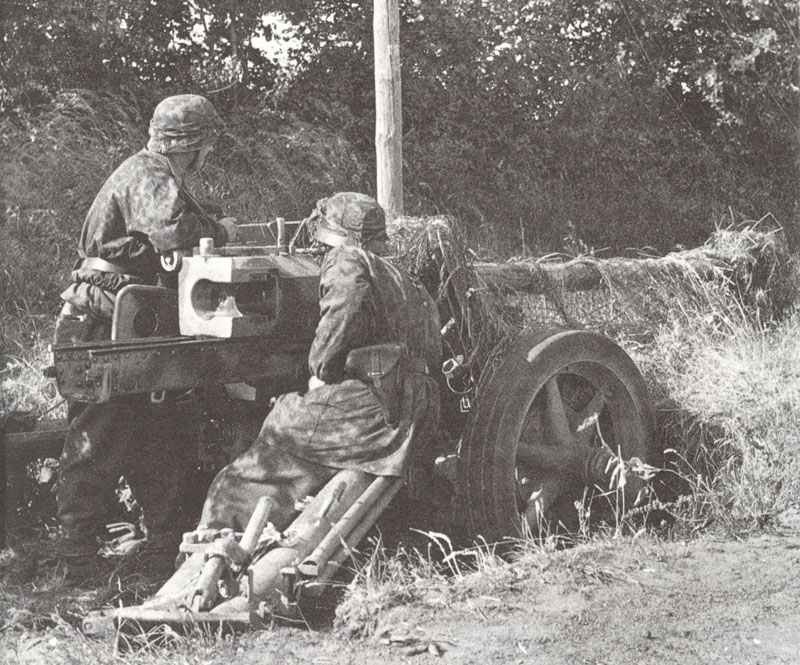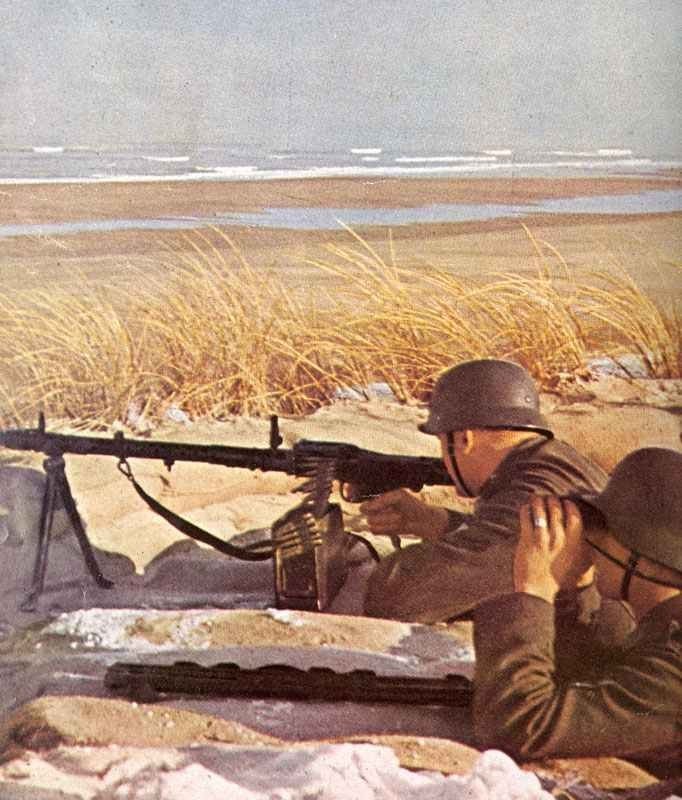German multi-jet heavy bomber Junkers Ju 287 with forward-swept wings.
History, development, service, specifications and pictures.
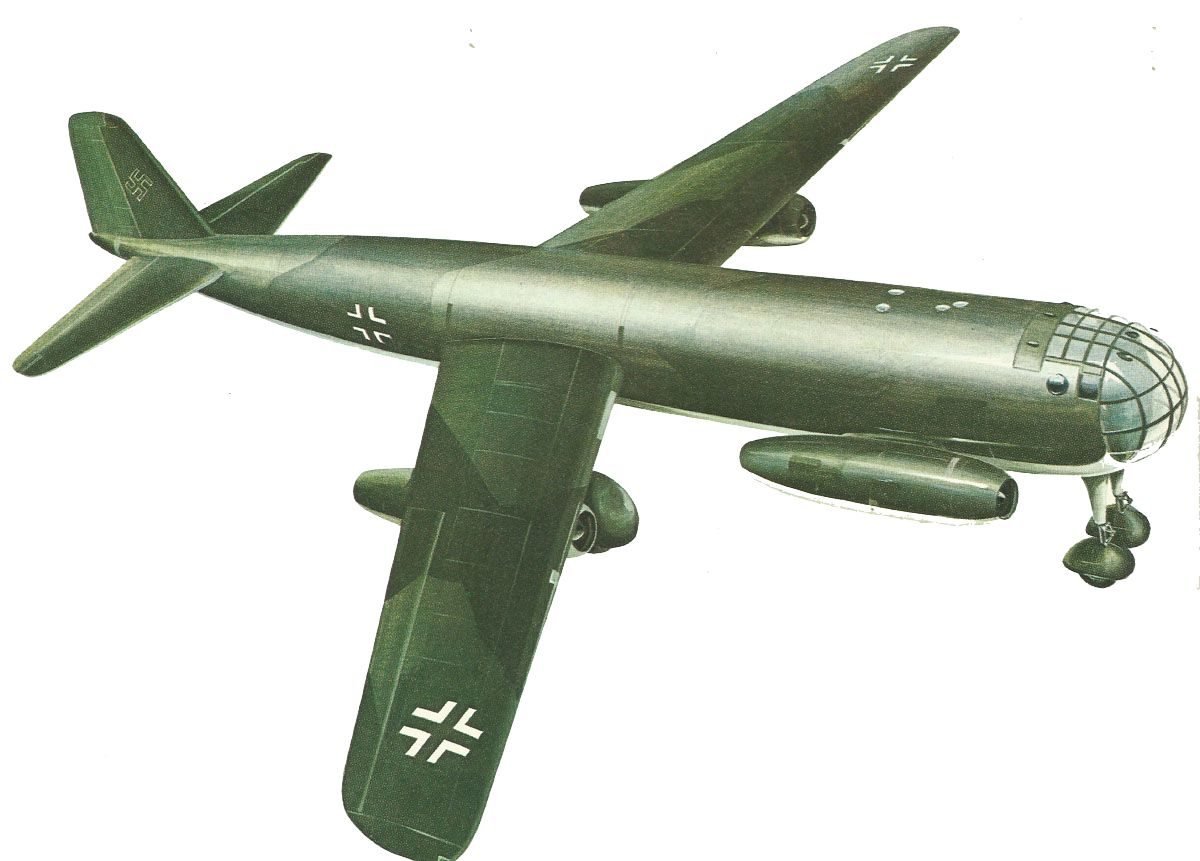
Junkers Ju 287
Type: Multi-jet heavy bomber with forward-swept wings.
History
Table of Contents
One of the most remarkable aircraft designs of the Second World War came from the work begun in early 1943 by Dipl-Ing Hans Wocke to build a heavy bomber with a maximum speed above that of contemporary fighter planes.
Jet engines and swept-wing technology gave the basic answers, but the use of the usual swept-wings at low airspeed remained a problem.
Therefore Wocke suggested the use of a forward-swept wing. These unusually forward swept wings would reduce the problems at low speeds, but would cause structural aeroelasticity problems of their own.
The origin of the Ju 287 can be found however in the search for a successor for the Junkers Ju 88. In the year 1942 the planned successor Ju 288 had still considerable weaknesses and the German air ministry Reichsluftfahrtministerium (or short ‘RLM’) assigned the company Junkers to convert the airplane to the Ju 288C.
Presumably in order to develop an even better bomber, an aircraft equipped with four DB 603 or Jumo 213 engines received the designation Ju 287 at the end of 1942.
Tests were carried out in the wind tunnel with swept wings, allowing a maximum speed of around 560 miles (ca. 901 km) per hour. Forward-swept wings were also tested to see what advantages they had over the usual swept wings.
Since the beginning of 1943 the aircraft was developed by Dipl-Ing Heinz Wocke, and he closely followed the design of the Ju 288.
Flying test-bed Ju 287 V1
However, this design program with the forward-swept wings was so radical that it was decided to build and fly a true-to-scale ‘flying test-bed’ as the Ju 287 V1.
This aircraft consisted of forward swept wings mounted on the fuselage of a He 177. For this the tail of a Ju 388, rigid main wheels of a Ju 352 and the nose wheel of a captured B-24 Liberator were used.
Two jet engines hung in nacelles under the trailing edges of the wings, while two more were mounted on the sides of the front fuselage. For launch, a pair of Walter 501 rocket packs were mounted under the engine nacelles, which were dropped after take-off.
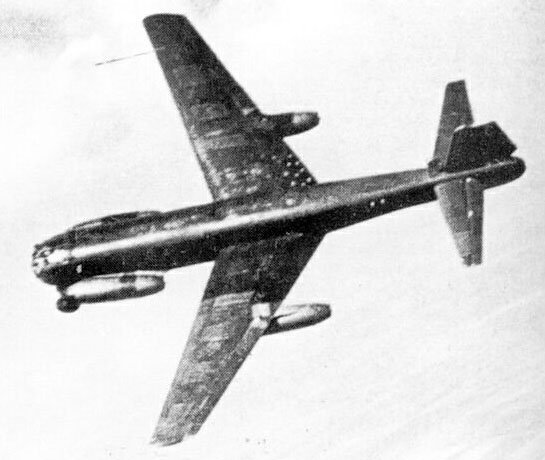
This ‘flying test-bed’ designed in this way first took off on 16 August 1944 and successfully completed at least 17 rather uneventful flight tests. This confirmed the reliability of the concept.
Previously, in March 1944, the preliminary specifications for two ‘real’ prototypes had already been established with the support of Colonel Siegfried Kneymeyer, Head of the German Air Force Technical Air Armament Department. It was expected that over one hundred Ju 287s would be ordered in the summer.
The specifications required a normal bomb payload of 6,620 lb (3,000 kg) at a range of about 1,240 miles (2,000 kilometres) without starting aids. For overload operations, a bomb payload of 8,800 lb (4,000 kg) was specified at a range of 1,100 miles (1,900 kilometres) using launching rockets.
For the series machines, armed with FHL 131/Z (twin 13mm-MG131) in a remote-controlled tail stand, a flying weight of 61,810 lb (28,000 kg) was accepted for the design. The jet engines were to consist of six BMW003 A-1, but Jumo 004 B-1 or 004 C-1 engines could also be installed without special modifications.
This marked the start of work on the Ju 287 V2 prototype, which had a new fuselage, retractable landing gear and six BMW 003A-1 jet engines in groups of three under the leading edges of each wing. This prototype was otherwise practically identical to the V1, only the elevator was 11.8 in (0.3 meters) larger.
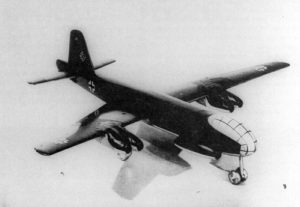
The airframe of the Ju 287 V3 was completely built from scratch. There was a pressurized cabin for three men, a weapon bay and the complete operational equipment for the standard Ju 287 A-1 jet bomber.
The Ju 287 B-1 was to be equipped with four 2,866 lb (12.750 kg) Heinkel-Hirth 011A1 jet engines, while the Ju 287 B-2 was to have two BMW 018 jet engines with 7,700 lb (34.260 kg) thrust.
Changes in arms priorities
In the summer of 1944, however, the situation for Germany became critical following the successful Allied invasion of Normandy. In addition, the allied bombers destroyed armament factories and the fuel industry without the German fighters being able to achieve significant defensive successes.
Therefore, the pressure on the Luftwaffe high command to concentrate on the construction of fighter planes increased. The outdated German bomber planes could neither support the ground troops on the western front nor bomb Great Britain anymore.
At the same time, the first V-1 flying bombs were launched against London on 12 June 1944. Within 10 days 1,000 of the bombs were fired and it seemed clear to the German leadership that without any loss of crews or expensive bombers they had now achieved more bombing effect on the British capital than had been the case with conventional attacks in the last two years.
Therefore, Hermann Göring ordered on June 27th to stop the construction of bomber planes and to concentrate on the production of fighter planes and V-weapons. In any case, the Reichs Marshal did not supervise his arrangement particularly, presumably because the rather limited range of 125 miles (ca. 201 km) of the V-1 limited the possible targets too much.
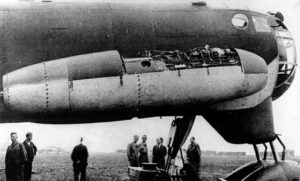
As with all other German bomber aircraft designers, Junkers continued to develop the Ju 287 underhand. Junkers chief pilot Siegfried Holzbaur finally started in Brandis near Leipzig on August 18 with the Ju 287 V1 for the first time.
Only four days later, however, the RLM (Reich Aviation Ministry) decided to drop the Ju 287 in order to use the production facilities at Junkers for the Ju 388 and the He 162 Salamander.
Therefore, on December 27, 1944, the Japanese General Oshima was allowed to inspect the aircraft together with the Ju 288, Ju 248 and Ju 88 Mistel construction. A short time later, the Japanese received the entire Junkers program for reproduction in 1945 and 1946.
However, the Ju 287 program was put back on the table as part of an investigation by a commission under Professor Bock for the America bomber. As a lightweight aluminum version without additional defensive weapons and the very latest engines, the jet bomber was quite capable of reaching North America.
At the same time, the conventional jet bomber version was redesigned at Junkers in order to consume as little strategic material as possible.
On February 25, 1945, however, it was decided that the Horten bomber was best suited as an ‘America bomber’. For the Ju 287, however, it was decided on March 17, 1945 that the aircraft should become the future heavy jet bomber (TL-Großbomber = large bomber) of the German Luftwaffe. Despite the increasingly critical situation at this time, 75 Ju 287 were to be built by July 1945.
The end of the Ju 287
The Ju 287 V1 was transferred to Rechlin at the beginning of 1945. There it was photographed by an allied reconnaissance aircraft and subsequently damaged in an air raid and was no longer airworthy. Probably it was then blown up by the retreating German troops before the arrival of the Red Army.
On April 16, 1945, American troops overran Brandis Air Base, where two days earlier the majority of the available aircraft and also the new test models of the Luftwaffe were destroyed by the withdrawing German personnel. However, the Ju 287 V2 was almost finished and undamaged and the US soldiers photographed it extensively. When the Americans had to hand over Thuringia to the Soviets, they set the Ju 248 found in Brandis on fire together with the Ju 287 V2.
However, the unfinished Ju 287 V3 with its two groups of BMW003 A-1 jet engines under the wings was captured by the Red Army. When the Americans arrived, their components had still been distributed to various plants in Thuringia. The US soldiers did not bother to collect them.
EF 131 for the Soviet Union
On 1 July 1945 Soviet troops occupied Thuringia with the destroyed Junkers factory. The Russians were soon able to reunite the majority of the workforce and provided for and treated them well under the circumstances. The facilities at Junkers were partially rebuilt and three months later a Soviet commission was able to view a new Ju 287 dummy. The project was now called EF 131.
Including the existing components of the Ju 287 V3 and with the now available Jumo 004 B-TL jet engines of the previous Luftwaffe jet fighter program, three prototypes of the EF 131 were planned. The larger fuel capacity of the Ju 287 B was also adopted, which meant that larger wheels and a new landing gear had to be developed for the higher weight.
Construction of the prototypes began around the turn of the year 1945-46. After only seven months of construction, the EF 131 V1 was ready to fly near Dessau in the summer of 1946.
However, the Russians did not want to carry out the actual flight tests near western spies and therefore the aircraft was disassembled again in autumn. But the Germans were told that the flight test should take place in Rechlin and the Russians put them together with the individual parts into the train. Instead, the cargo and Dr Wocke, together with his development team, drove to Russia in the Moscow area. The German test pilots were brought to Moscow by plane.
However, the Soviet experimental station was not yet prepared, so that the flight tests for the two reassembled prototypes were delayed. Meanwhile, on October 22, 1946, another 5,000 engineers and employees of the Junker plant, together with their relatives, were put into railway trains to Russia. The entire plant was also dismantled and rebuilt in the Soviet Union.
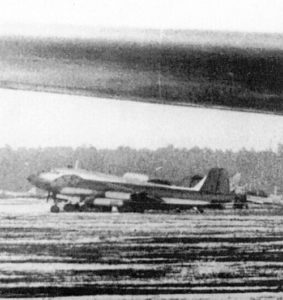
In October 1946, but at the latest in summer 1947, the EF 131 V1 is said to have flown with the German test pilot Dülgen for the first time at Podberezhy. Up to four prototypes are said to have been built for the Soviets.
Subsequently, an EF 140 reconnaissance aircraft with a range of 2,175 miles (ca. 3,500 km) with two Soviet Mikulin AM-2 jet engines, each with a launch thrust of 7,064 lb (3,200 kg), was developed. But then the Soviets took over the testing and further development of the former Ju 287 and the Germans did not see the aircraft anymore.
In any case, no Soviet jet bomber or long-range reconnaissance aircraft with forward-swept wings appeared in the post-war period. The Soviet Union, however, saw itself as the world’s strongest land power in the soon to come ‘Cold War’, which could only be threatened by the new American atomic bombs. This threat could only be countered with the capability of a nuclear counter strike, which required long-range jet bombers as carriers. The EF 131 therefore offered the Soviets the opportunity to develop their own suitable atomic bombers within a relatively short time.
At the beginning of 1952 the Tupolew Tu-16 appeared, which could carry a payload of 6,625 lb (3,000 kg) with a maximum speed of about 620 mph (1,000 km/h) over a distance of 3,580 miles (5,760 kilometres).
Users: Germany, Soviet Union (post-war period).
Specifications for Junkers Ju 287 V1
The following specifications are from the 1944 flown Ju 287 V1, the ‘flying test-bed’, which only had a rigid landing gear and therefore could not be flown with the possible maximum speed.
| Junkers Ju 287 V1 | Specification |
|---|---|
| Type | flying test-bed |
| Power plant | 4 x 1,984 lb (900 kg) st Jumo 004B-1 Orkan |
| Accommodation | 2 |
| Wing span | 66 ft (20.12 m) |
| Length overall | 59 ft 11.7 in (18.28 m) |
| Height overall | 17 ft 8.6 in (5.40 m) |
| Wing area | 627.54 sq ft (58.30 m²) |
| Weight empty | 27,558 lb (12,500 kg) |
| Weight loaded | 44,092 lb (20,000 kg) |
| Max wing loading | 70.26 lb/sqft (343.05 kg/m²) |
| Max power loading | 5.55 lb/lb st (5.55 kg/kg st) |
| Maximum speed | 347 mph (559 km/hr) at 19,685 ft (6,000 m) |
| Cruising speed | 318 mph (512 km/hr) at 22,965 ft (7,000 m) |
| Initial climb | ? |
| Service ceiling | 35,435 ft (10,800 m) |
| Range | 932 miles (1,500 km) |
The standard Ju 287A-1 bomber could have delivered 8,830 lb (4,000 kg) of bombs at a speed of 493 mph (793 km/hr) over a distance of 985 miles (1,585 kilometres) and with a defensive armament of two 13 mm MGs in the remote-controlled rear stand and 3-man crew.
References and literature
German Aircraft of World War 2 in Colour (Kenneth Munson)
Warplanes of the Luftwaffe (David Donald)
The Luftwaffe Album, Bomber and Fighter Aircraft of the German Air Force 1933-1945 (Joachim Dressel, Manfred Griehl)
Junkers Ju 287 und EF 131 (Uwe W. Jack)




